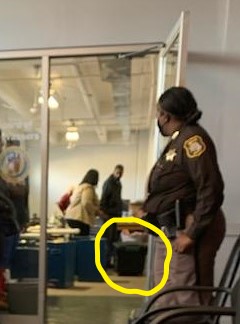By Patrick Colbeck
On July 27, 2023, Speckin Forensics released a professional report on the results of its audit of select 2020 election records for the City of Detroit.
The report seems to validate many of the affidavits submitted by poll challengers as well as public testimonials provided by citizens in the wake of the 2020 general election.
What Was Reviewed?
Speckin Forensics was tasked to review the “ballots, envelopes, totals tapes, record books and other associated documents for the 2020 election”. The review included Precincts 1-503 and Absentee Voter Counting Boards (AVCB) 1-134.
Their review included comparisons of vote totals on the tapes (in-person) and printouts (AVCB) to the ballots present to be counted. Only 2 AVCB boards (AVCB 79 and AVCB 122) were reviewed to match up each returned ballot with a corresponding application since it was a very time-consuming process.
Key Findings
These findings in the Speckin Forensics report reinforce other previously-submitted evidence of election malfeasance.
| Finding | Description | Remarks |
| Printing Inconsistencies | Some ballots were printed lighter than others | This indicates that there were likely multiple sources for ballots. |
| Paper Inconsistencies | Some ballots felt thicker than others | This indicates that there were likely multiple sources for ballots. |
| AV Ballots Without AV Applications | Almost 20% of ballots in AVCB 79 were not associated with an application. When subtracting those on “permanent AV list”, this discrepancy drops to 12%. Almost 8% of ballots in AVCB 122 were not associated with an application. When subtracting those on “permanent AV list”, this discrepancy drops to over 6%. Since 170,000 absentee ballots were cast, there were likely between 13,600 and 34,000 ballots cast without any application requesting the ballot. | While unsolicited absentee ballot applications were indeed sent out under direction of the Michigan Secretary of State Jocelyn Benson, in order to receive a mail-in ballot, an application needed to be received by the clerk. There are anecdotal examples, however, of voters being assigned to permanent AV list without having requested to to be on this list. This practice has now been enshrined in MI Constitution upon passage of Proposal 22-2. In some instances, post it notes were found in the files that included “Ballot doesn’t match poll book” or “not on list in QVF” or “not on list”. Please note that the only way to access the QVF would be via an internet connection. Detroit election officials have repeatedly denied the existence of internet connections at the AVCB. |
| Unbalanced AV Counting Boards | The total number of envelopes did not equal the total number of ballots for each AVCB. For example, AVCB 18 contained 43 more envelopes than ballots. AVCB 38 contained 40 more ballots than envelopes. | In the 2020 election, 71% of the AV Counting Boards failed to balance causing Republicans on the Wayne County Board of Canvassers to vote No on certification. |
| Vote Tally Discrepancies | AVCB’s 33, 57 and 58 all reported ZERO votes on printouts yet non-zero vote tallies were reported to the state. AVCB 49 reported 965 votes for Biden yet ballots only add up to 902 votes. | Absentee vote tallies for Detroit AVCB are provided by EMS Servers. In-person vote tallies are provided by Dominion Image Cast Precinct tabulators. |
| Missing Ballots | AVCB 13 reported 1,566 ballots to the state yet the number of ballots scanned and shown on the printouts are 1,621 resulting in 55 missing ballots. AVCB 15 reported 1,795 ballot envelopes yet total ballots on printouts were 1,765 resulting in 30 missing ballots. In AVCB 23, the number of ballots scanned per printout was 2,855 yet the total ballots presented was on 2,818 resulting in 37 missing ballots. Similar anomalies were found in other AVCB’s. | There are affidavits from poll challengers asserting the use of non-approved ballot containers subject to tampering. |
| Missing Envelopes | In AVCB 26, the total number of scanned ballots per printout was 3,430 yet the number of envelopes was only 3,385 resulting in 45 missing envelopes. |
The following photos were included in the Speckin Forensics report.


What Was Not Reviewed?
Notably absent from the audit was a review of the electronic records. Examples of electronic records that were not examined include:
- Electronic poll book transaction logs
- Image Cast Central (ICC) tabulator Cast Vote Records
- Adjudication Workstation transaction logs
- Results Transfer Management (RTM) laptop transaction logs
- Election Management System (EMS) Server transaction logs
- Splunk logs from various switches and routers
In fact, the Speckin analysis made the following assertion in association with the vote tally discrepancies observed:
“Duplicate scanning and counting of ballots is possible and could account for this discrepancy but the computer and system data including the scans of the ballots from the tabulators would need to be examined to confirm or deny this possibility.”
In addition to the lack of examination of electronic vote records, there was no apparent attempt or ability to provide a precinct-level analysis of the AVCB’s. In Detroit, each AVCB features votes from 3-5 precincts. Under MCL 168.812, precinct-level election results (not AVCB results) are to be submitted to the state. Detroit has a habit of not complying with this law. Without a precinct-level analysis, election officials are able to move votes and voters around within an aggregate slush fund composed of 3-5 precincts. This provides them with flexibility to account for any conflicts that might arise from voters showing up to vote in-person when their vote has already been cast as an absentee vote. As a minimum, this bookkeeping approach unnecessarily complicates attempts to audit election returns via the introduction of an additional series of analyses.
Possible Explanations
The following table contains a list of possible explanations for each finding.
| Finding | Possible Explanation |
| Printing Inconsistencies | Differences might be explained by insertion of “test ballots” into election records. Detroit contracted with Miller Consultations to provide test decks for 503 precincts in Detroit. Only 14 precinct tabulators were subject to public accuracy testing in preparation for 2022 election. The 2020 election likely featured a similar count. So why would Detroit pursue a contract to provide test ballots for 503 precincts? Democrat Mayoral Candidate Tom Barrow filed a complaint citing the failure to secure test ballots and asserting that these ballots were likely used to change election results in his primary contest with Detroit Mayor Mike Duggan. |
| Paper Inconsistencies | Differences might be explained by insertion of “test ballots” into election records. Detroit contracted with Miller Consultations to provide test decks for 503 precincts in Detroit. Only 14 precinct tabulators were subject to public accuracy testing in preparation for 2022 election. The 2020 election likely featured a similar count. So why would Detroit pursue a contract to provide test ballots for 503 precincts? Democrat Mayoral Candidate Tom Barrow filed a complaint citing the failure to secure test ballots and asserting that these ballots were likely used to change election results in his primary contest with Detroit Mayor Mike Duggan. |
| AV Ballots Without AV Applications | The estimated number of ballots without AV applications (13,600 to 34,000) correlates with estimates of the number of ballots dropped off at the back of the Detroit AVCB center at 3:30am during the morning of November 4, 2020. Perhaps these ballots were kept in reserve should the need arise for the injection of ballots to obtain someone’s desired election outcome. New poll books were transferred to the Wayne County Board of Canvassers thirteen days after the election and six days after all voter history data is required to be uploaded to the state Qualified Voter File per MCL 168.813. It sure appears that someone is attempting to update the election records to reflect their desired election results. |
| Unbalanced AV Counting Boards | If a precinct is unbalanced, it cannot be subject to a recount. In Detroit, 71% of its 134 AVCB’s were unbalanced and therefore not subject to a recount. This is convenient for anyone seeking to prevent an examination of the ballots. |
| Vote Tally Discrepancies | Dominion contractor Mellissa Carone submitted a signed affidavit attesting to duplicate scanning and counting of ballots. Vote tallies may also have been “adjusted” manually or via algorithms at RTM Laptops, Adjudicator Workstations, or the EMS Server. Examination of electronic records would be needed to know for sure. See Detroit Elections: Smoke and Mirrors. |
| Missing Ballots | Ballots were discarded. |
| Missing Envelopes | Ballots were injected into election record by corrupt election officials as mail-in ballots. |
The “black box” containing new poll books 13 days after the election can be seen in the following photo taken by a poll challenger at the Wayne County Board of Canvassers.

Prior to the insertion of these new poll books, Detroit precincts were out of balance by as many as 600 votes in a single precinct. After the insertion of these new poll books, the maximum out of balance total was 29. It was clearly an attempt to provide a measure of consistency between the number of ballots and the poll book records.
The core issue with Detroit’s AVCB election practices is the utter lack of any chain of custody regarding the ballots counted at the AVCB. Poll challengers are given no means of determining whether or not a given ballot at the AVCB was cast by a legitimate voter or conjured up in a “Chicago Warehouse” serving as a ballot factory.
Conclusion
Evidence of Detroit election malfeasance continues to grow. On November 4, 2020 I witnessed upwards of 34,000 ballots being dropped at the rear entrance of the TCF Center at 3:30am with ZERO chain of custody documentation. Now we learn from the Speckin Forensics analysis that upwards of 34,000 ballots were not associated with any absentee ballot application. I don’t believe in coincidences. It certainly appears that 34,000 “mail-in” ballots were injected into the vote count as a last minute adjustment to the 2020 election results.
As of the 2022 general election, Detroit has 508,535 registered voters. This represents a significant “slush fund” of voters to choose from in a pinch if the election results are not to one’s liking. The vote margin in Michigan for the 2016 Presidential election was only 10,704 votes. When will Detroit finally be held to the highest standards of election integrity instead of it constantly being given a pass for sloppy bookkeeping?
Related Posts
- Detroit Elections: Smoke and Mirrors
- How Exactly Does Mail-In Ballot Cheating Occur?
- Election Results Are Missing Key Audit Trail Links





Thnnnxxx.